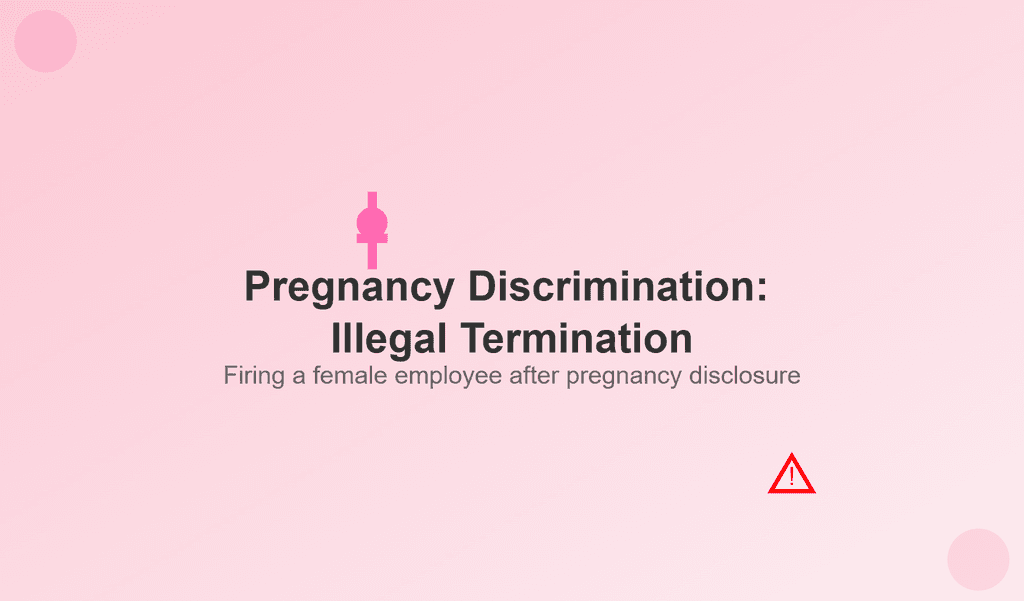Understanding what constitutes an illegal reason to fire someone is essential for both employees and employers. Terminating a worker unlawfully can lead to legal disputes, reputational harm, and financial penalties.
In this post, we break down the most common types of wrongful termination and how to identify them.
🚫 What Is an Illegal Reason to Fire Someone?
Firing becomes illegal when it violates federal, state, or local employment laws. This typically includes termination based on:
- Discrimination
- Retaliation
- Violation of contract or public policy
- Exercising legal rights
Knowing these categories can help protect your business or defend your employment rights.
1. Discrimination-Based Termination
It is illegal to terminate an employee based on characteristics protected by law. According to the Equal Employment Opportunity Commission (EEOC), employers cannot fire someone due to:
- Race or ethnicity
- Gender or sex, including pregnancy and gender identity
- Sexual orientation
- Religion
- National origin
- Age (if 40 or older)
- Disability
- Genetic information
✅ Example: Firing a female employee after she discloses her pregnancy violates the Pregnancy Discrimination Act and is considered illegal.

2. Retaliation for Protected Activities
Employees have the right to engage in certain legally protected activities. Firing someone in retaliation for exercising these rights is unlawful.
Illegal retaliation includes firing someone for:
- Reporting discrimination or harassment
- Filing a workers' compensation claim
- Participating in an internal or government investigation
- Reporting safety violations to OSHA
- Whistleblowing on fraudulent or illegal activities
🔍 Tip: Employers must document performance issues and avoid taking action immediately after an employee engages in protected conduct.
3. Breach of Employment Contract
If an employee has a written or implied contract, terminating them without honoring the terms may be illegal.
Examples of breach include:
- Terminating before the contract ends without cause
- Violating the stated termination procedure
- Ignoring promised severance or notice terms
4. Violation of Public Policy
Some firings may violate public policy, even if no contract exists.
This includes termination for:
- Taking time off for jury duty
- Voting or serving in the military
- Refusing to commit illegal acts on behalf of the employer
- Reporting criminal activity
These actions are legally protected, and firing someone for them is prohibited.
5. Exercising Legal Rights
It is also illegal to fire an employee for asserting specific workplace rights under federal or state laws.
Common examples:
- Requesting medical or family leave under FMLA
- Asking for reasonable accommodations under the ADA
- Discussing wages with coworkers (protected under NLRA)
- Filing a wage complaint for unpaid overtime
⚖️ What To Do If You Were Illegally Fired
If you suspect you've been fired for an illegal reason, take the following steps:
- Document everything – emails, termination notice, witness accounts.
- Request clarification on the reason for termination.
- Consult an employment attorney.
- File a complaint with the EEOC or state labor board.
Employers should also conduct regular HR training to prevent unlawful terminations and reduce legal risk.
🧠 Final Thoughts: Protecting Workplace Fairness
Understanding illegal reasons for termination protects both employees from wrongful dismissal and employers from legal consequences. Knowing the law helps build a safer, more transparent workplace culture.
For HR teams, regular training and legal reviews are essential. For employees, knowing your rights is the first step in standing up against unfair treatment.
📌 Frequently Asked Questions
❓ Can you be fired without a reason?
Yes, in “at-will” states, employers can fire employees without cause. However, it cannot be for an illegal reason, such as discrimination or retaliation.
❓ How do I prove wrongful termination?
Gather documentation, emails, timelines, and any witness statements. An employment lawyer or the EEOC can help build your case.
❓ Is it legal to fire someone for poor performance?
Yes, if documented properly and not used as a cover for discrimination or retaliation.
Related Searches:
- What are wrongful termination examples?
- Can you sue for being fired unfairly?
- How to file a complaint with the EEOC?
Need help drafting legal HR policies or preventing wrongful termination issues? Contact our HR compliance experts today.
